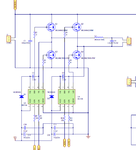naseerak
Full Member level 5
Hi
I have done many designs on H-bridge from opt-couplers and discrete logic to dedicated H-Bridge drivers. But Now I want to design a sine wave inverter using push pull transformer with center tape. actually one of my design based on atmega8 has a square wave out put now I want to change the software making an spwm signals driving the same center taped transformer with addition of filter cap on the output if the transformer. I want your suggestions before getting in to it currently I am using 12-0-12 to 280 v transformer.
Regards
I have done many designs on H-bridge from opt-couplers and discrete logic to dedicated H-Bridge drivers. But Now I want to design a sine wave inverter using push pull transformer with center tape. actually one of my design based on atmega8 has a square wave out put now I want to change the software making an spwm signals driving the same center taped transformer with addition of filter cap on the output if the transformer. I want your suggestions before getting in to it currently I am using 12-0-12 to 280 v transformer.
Regards


